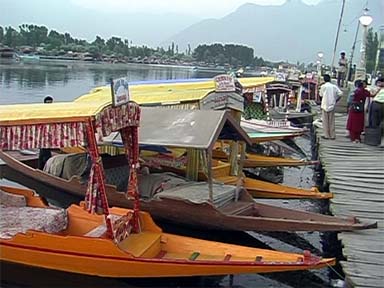Apr 13, 2025
Apr 13, 2025
 The world-famous Dal lake, one of the world's largest natural lakes, is dying. In Srinagar city in Jammu and Kashmir, the lake carries the burden of 100 hamlets, many floating gardens and several hotels and lodges.
The world-famous Dal lake, one of the world's largest natural lakes, is dying. In Srinagar city in Jammu and Kashmir, the lake carries the burden of 100 hamlets, many floating gardens and several hotels and lodges.
Once heart-wrenchingly beautiful, the lake today takes in all the city's sewage. Human refuse from the houseboats is discharged into the lake. As a result, the quality of the lake's water has deteriorated and its vast reserves of aquatic life are rapidly shrinking. The growth of a mysterious red weed during the last decade has further choked the lake.
Besides being a tourist attraction and a source of livelihood to hundreds of people, the Dal has also inspired several poets and painters. But local people, who have observed the ecological damage over the years, warn that in another 50 years the Dal will be reduced to a dirty pond. Its beautiful floating gardens will be seen only in picture books.
In 1200 AD, the Dal's spread covered an area of 75 sq km. By the 1980s, only 25 sq. km survived, and today the Dal stretches over barely 12 sq. km.
A state government report of 1970 warned that human settlements, water pollution, construction within and on the periphery of the lake, and continued agricultural activity (like the floating gardens), would lead to steady degradation of the lake. But the report was not taken seriously.
Today 300,000 people live in the catchment area and over 30,000 live on the lake itself, tending to their floating gardens. The floating gardens, which provide almost 50 per cent of the vegetables to the entire Kashmir Valley, are now threatening the very existence of the lake. Plant debris from the floating fields has made the lake shallow (from 17 feet a decade ago, it is now only 9 feet deep).
Although the state administration has tried to relocate the lake's farmers, it has not met with much success. Farmer Hafiz Hussain and his family were part of the group which was rehabilitated in six residential colonies in Srinagar three years ago. The family returned to the lake after six months. "We were given houses and some compensation, but no source of livelihood," laments Hussain.
Over the years, uncontrolled building activity has further damaged the lake. Leading city lawyer Shakil Akhtar says that in Kashmir, people have proprietary rights over water bodies granted to them by the rulers of the area almost 100 years ago. Taking advantage, some residents have filled in large parts of the lake and constructed hotels. One such case is that of Abdullah Ansari, who has built two hotels on the lake. When the state government tried to evict him, he produced a 'water deed' given to his grandfather by one of the kings. In the last two decades, over 14 hotels have come up on the Dal.
The biggest and consistent threat to the Dal has always come from the city's sewage. Tanveer Jahan, Vice-chairman of the Lakes and Waterways Development Authority (LWDA) states that Srinagar city still does not have a proper sewage and drainage system. All the city's waste is pumped into the lake without being treated. A recent report from the Directorate of Environment (Kashmir) stated that the disposal of sewage was one of the main factors behind the growth of algae in the lake. LWDA has already set up 10 floating septic tanks underneath the lake waters, which will be cleaned once a year. It plans to set up 350 more such tanks within the next two months.
Over the past five years, an NGO, Hope, has also tried to address the problem of solid waste management. Saqib N Qadri, Vice-chairman of HOPE, says every day five truckloads of waste is collected from the farmers and those living in houseboats. "Initially, it was a difficult task to involve people spread over 100 hamlets. But three years of constant counselling has helped run the project smoothly," he adds.
The Houseboat Owners' Association President, Abdul Aziz, says that the families suffered a lot during the insurgency years. For more than a decade, there was no tourism in the state. "A sum of Rs 30,000 (1US$=Rs 45) is required every year for maintenance of a houseboat, regardless of whether there have been guest-occupants or not. Many houseboat owners took heavy loans during the insurgency years."
LWDA says it has drawn up an ambitious plan to save the lake in the next five years. But it admits that raising Rs 2,300 million for the task would be a severe challenge. The state government is considering setting up a Dal Lake Preservation Fund.
Revival of tourism, in the last two years has brought its own problems. In the peak tourist months - April to July - the Dal is choked with plastic bags and coke cans. The state administration recently announced its plans to penalise those who litter the lake. But like several of its plans, it may be implemented too late in the day.
20-Jun-2004
More by : Prakriiti Gupta